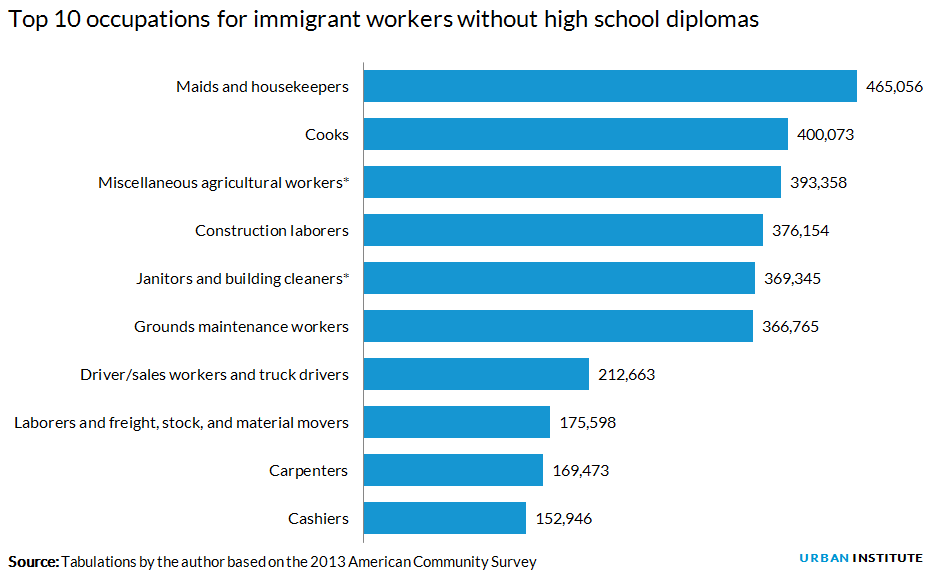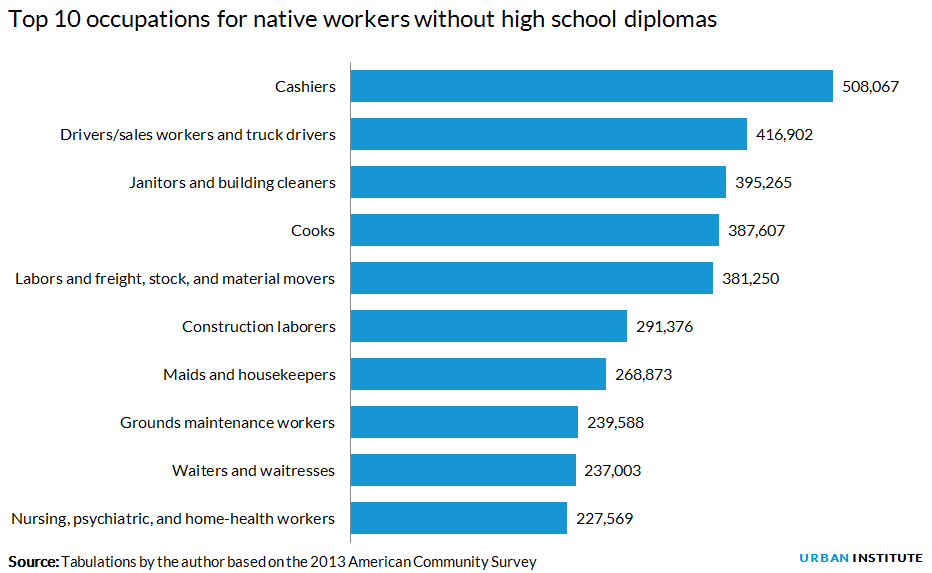
<p>In this May 10, 2011 photo, a field worker passes through a vidalia onion farm in Lyons, Ga. (AP Photo/David Goldman)</p>
A large and growing share of the low-skilled workforce are immigrants, many of whom are unauthorized. This often makes people think that immigrants are pushing US citizens out of their jobs. To bring some evidence to this contentious issue, I set out to find what types of jobs low-skilled natives and immigrants hold. I found that, even within the narrowly defined group of workers with no high school diploma, immigrants and natives do different jobs.
In 2013, the foreign-born population accounted for 44 percent of the 16 million workers that have no high school diploma. While the number of US-born workers without high school degrees is declining, the number of immigrant workers with this same education level is increasing. And the low-skill labor market is growing. The Bureau of Labor Statistics projects that, by 2022, there will 4 million additional jobs in occupations that do not require a high school diploma, more than any other educational category except for high school graduates.
How similar are immigrant and native workers?
Even among those without high school diplomas, immigrant and native workers can be quite different, and these differences may affect their access to jobs. For instance, many immigrants are not fluent in English, which can limit their access to certain jobs. Also, natives can work legally in jobs requiring state licensing, but unauthorized immigrants cannot.
In addition, even without a high school diploma, most natives have some high school education, while many immigrants have very low levels of education. Immigrants who are bilingual may be better suited for certain jobs than natives who only speak English. And immigrants may also be more proficient in manual skills than natives are, because many of them come from countries less economically developed than the United States.
An Urban Institute study showed that occupational dissimilarity between natives and immigrants is larger among those without a high school diploma than among workers at any other level of educational attainment.
What jobs do immigrants and natives hold?
The top three occupations with the largest number of immigrants without high school diploma are maids and house cleaners, cooks, and miscellaneous agricultural workers.
In contrast, the occupations with the largest number of native workers without high school degrees are cashiers, truck drivers, and janitors and building cleaners.
The top three occupations in which less-educated immigrants are most over-represented are miscellaneous personal appearance workers, such as manicurists (87 percent immigrant); workers who grade, sort, and classify unprocessed food and other agricultural products (82 percent); and sewing-machine operators (81 percent).
The top three occupations in which less-educated natives are most over-represented are counter attendants in cafeterias, food concession stands, and coffee shops (86 percent native workers); hosts and hostesses at restaurants, lounges, and coffee shops (85 percent); and receptionists and information clerks (81 percent).
Less-educated native workers are over-represented in occupations that interact with the public and coworkers and that have supervising responsibilities, licensing requirements, and demanding mechanical and computer operations. Immigrants dominate manual jobs, occupations that are more physically demanding, and jobs where interactions with the public happen in more controlled settings (e.g., taxi drivers, maids)
These findings suggest that immigrants and native workers with low levels of education may be competing for different jobs and even could be complementing each other. Immigration status can constrain a worker’s job choices, but many immigrants are working different jobs from natives because they have limited English language or technical skills, or because they have insufficient exposure to the US workplace. If undocumented immigrants become authorized to work in the United States, that still may not be enough to increase competition with natives for low-skilled jobs.


Top 10 occupations that are most over-represented by native and immigrant workers without high school diplomas
Native workers
- Counter Attendants, Cafeteria, Food Concession, and Coffee Shop (86%)
- Hosts and Hostesses, Restaurant, Lounge, and Coffee Shop (85%)
- Receptionists and Information Clerks (81%)
- Secretaries and Administrative Assistants (79%)
- Customer Service Representatives (79%)
- First-Line Supervisors of Office and Administrative Support Workers
(78%) - Office Clerks, General (78%)
- Teacher Assistants (77%)
- Security Guards and Gaming Surveillance Officers (77%) 10. Cashiers (77%)
Immigrant workers
- Miscellaneous Personal Appearance Workers (87%)
- Graders and Sorters, Agricultural Products (82%)
- Sewing Machine Operators (81%)
- Miscellaneous Agricultural Workers, Including Animal Breeders (77%)
- Chefs and Head Cooks (75%)
- Taxi Drivers and Chauffeurs (68%)
- Drywall Installers, Ceiling Tile Installers, and Tapers 67%)
- Packaging and Filling Machine Operators and Tenders (66%)
- Butchers and Other Meat, Poultry, and Fish Processing Workers (64%)
- Maids and Housekeeping Cleaners (63%)
Note: Natives are 56 percent of all workers with no high school diploma. Over-representation is defined as 5 percentage points above the overall representation. For natives, this is 61 percent or more, and for immigrants, 49 percent or more
Let’s build a future where everyone, everywhere has the opportunity and power to thrive
Urban is more determined than ever to partner with changemakers to unlock opportunities that give people across the country a fair shot at reaching their fullest potential. Invest in Urban to power this type of work.